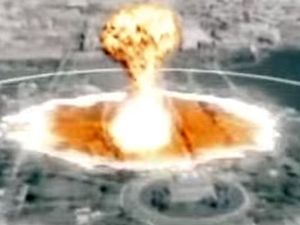A few defense and security-related stories from around the region to start your week:
A dramatic propaganda reveal. Amid rapid improvements to its nuclear weapons program, North Korea released a propaganda video on Saturday that, among other things, shows a nuclear strike on Washington, DC. North Korea regularly threatens the United States and South Korea with violence, particularly during this time of the year, when the two allies undertake their extensive Key Resolve and Foal Eagle military exercises. Pyongyang’s dramatic propaganda reveal comes days after its purported to test a solid-fuel propellant for its still-untested intercontinental ballistic missile.
Watch the video here:
Spy versus spy in the subcontinent. India and Pakistan are currently mired in a diplomatic row over Pakistan’s claim that a former Indian navy officer arrested in Balochistan was a spy collecting intelligence for India’s Research and Analysis Wing (RAW). India rejected the Pakistani claims. Pakistan has in the past alleged that New Delhi is fomenting instability in Balochistan–a charge that New Delhi denies.
In case you missed it: China’s invitation to RIMPAC in jeopardy. Last week, the United States suggested that the Chinese People’s Liberation Army-Navy’s invitation to the Rim of the Pacific 2016 exercise–the largest naval exercise in the world–is potentially under review. The PLAN has “an invitation for RIMPAC, and we will continue to review that,” U.S. Defense Secretary Ashton Carter told the House Armed Services Committee. “We are constantly reassessing,” he added. Withdrawing China’s invitation to RIMPAC would be a blow to U.S.-China military-to-military contacts and would represent a significant departure in the Obama administration’s diplomacy toward Beijing, which has been characterized by firm rhetoric but little in the way of active retaliation for bad behavior, in the South China Sea and elsewhere. (You may also be interested in cases for and against China’s participation in RIMPAC in The Diplomat from last year: Dingding Chen speaks in favor and I speak against.)
Catch up on the China-Indonesia stand-off in the Natuna Sea. The Diplomat has had extensive coverage and analysis of the stand-off last weekend between Indonesia and China in the Natuna Sea, in the southern reaches of the South China Sea. Ristian Atriandi Supriyanto digs into the chronology and specifics of the incident. Supriyanto, along with Shahriman Lockman and Koh Swee Lean Collin, examine the broader implications of the incident. Carl Thayer takes a pessimistic view, suggesting that the stand-off suggests that matters will get worse in the South China Sea before they get better. Prashanth Parameswaran offers important context, noting that the incident isn’t entirely without precedent, and goes on to explain the “delicate equilibrium” inherent in Indonesia’s South China Sea policy and the reasons why we should expect continuity instead of change from Jakarta. Prashanth and I discussed the stand-off and its implications on last week’s podcast as well.
































